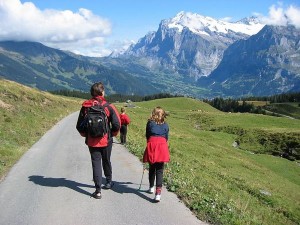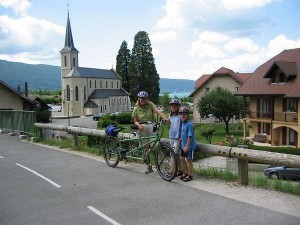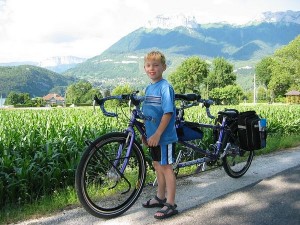So. You think you would like to do a year around the world but don’t know where to start. You’ve come to the right place.
I don’t think any one book or any one person can tell you how to plan and execute a trip of this magnitude. Further, there is no way you can plan a trip like this in detail as you might a two-week vacation. Get used to the idea that trying to find accommodations at your next destination is your full-time job.
As with almost everything, the more you know about something, the more there is to know. By far the best advice is simply, “Don’t panic.”
That said, here is my advice.
How Much Does It Cost?
 The number one question people have, but are often afraid to ask is, “How much does it cost to go around the world?” The quick and easy answer is that I don’t see how it can be done for less than $30,000 per person.
The number one question people have, but are often afraid to ask is, “How much does it cost to go around the world?” The quick and easy answer is that I don’t see how it can be done for less than $30,000 per person.
Our total cash outlay was $121,275.89 for four people. OK, so I’m a bit obsessive about numbers. We also spent $29,971.60 before we even set a toe on a plane. Wow! That sure is a lot of money to spend before you even start! That’s what we thought, too, but we had to take care of several up-front costs, such as plane tickets, equipment, clothing, vaccinations, and medical insurance.
Thirty-thousand dollars per person seems like a lot of money, too. It is, but there is very little “air” that can be squeezed out of those figures. For example, we spent less than $100 on souvenir shopping for the entire year.
Methods to reduce costs would be to reduce the number of countries visited, or travel by bicycle, as getting from point “A” to point “B” was one of the biggest line items in our budget. We were very thrifty when it came to food and accommodations. Unless you can eat just bread and peanut butter and sleep outdoors full-time, it isn’t possible to travel much cheaper than we did.
Of course nothing is as simple as entering in a number in a spreadsheet, which begs the next question…
How Can I Come Up With a Realistic Budget?
 We came up with our budget by taking a four-week trip to the most expensive place we planned on visiting during our world tour: Switzerland. We took this trip three years before our estimated departure, partly to assist us in understanding costs, but also to understand our equipment needs, and how we reacted as a family traveling together.
We came up with our budget by taking a four-week trip to the most expensive place we planned on visiting during our world tour: Switzerland. We took this trip three years before our estimated departure, partly to assist us in understanding costs, but also to understand our equipment needs, and how we reacted as a family traveling together.
From that trip we obtained a good estimate of the costs associated with traveling for a month, which we could adjust for inflation and changing exchange rates, and then extrapolate out to one year.
More importantly, the costing exercise was specifically for the kind of traveling we planned to do, which will be different for different tastes, budgets and styles. Some people drive Toyotas, and others Jaguars. We’re Toyota people. One can’t expect to stay at five-star resorts for 12 months on $30,000 per person.
That one-month trip to Switzerland served as a basic building block of our budget, and we determined that we needed about $5,000 per month in “living expenses” on the road. Our actual expenses for our year-long trip ended up averaging $6,500 per month. The difference between projected and actual was made up largely by the abysmal performance of the dollar when we hit the road and after a while, we needed to start eating and sleeping better than we had been.
There are, of course, lots of other line items on the budget that need to be included, other than monthly living expenses. For example, the cost of maintaining real estate at home was a very big line item for us, and is not included in the numbers I have quoted. Even though we rented our house out for the year, there were still some significant expenses, such as property taxes, that we had to cover.
Here is a rough breakdown of our expenses for the year:
Plane tickets for four people: $30,000
Overland day-to-day expenses
($6,500 per month): $78,000
Medical insurance: $2,600
Equipment, clothes: $2,500
Children’s books, guide books (incl. global shipping): $2,000
Storage for household items: $4,000
Immunizations: $2,000
Total: $121,100
OK, if you’re good at on-the-spot math, you’ll be wondering where the extra $175.89 went. I can’t tell you for sure, but it probably went into the cash register at various Chili’s locations worldwide for Molten Chocolate Cake.
BudgetYourTrip.com is a great resource to use when trying to develop your own budget, and see how it stacks up against others who have visted the same areas you are planning to visit.
Expenses Not to be Underestimated
Clothing
 You seem to have enough clothes to wear at home, so why should you need to spend a lot of money on clothes for a trip? We started our trip on bicycles and expected to be on them for many months, so believe me, the one pair of shoes and the one pair of pants and the one sweatshirt and the one windbreaker all had to be the lightest, most durable variety we could find. Of course, all this “lightweight” clothes buying was completely negated by our mobile library.
You seem to have enough clothes to wear at home, so why should you need to spend a lot of money on clothes for a trip? We started our trip on bicycles and expected to be on them for many months, so believe me, the one pair of shoes and the one pair of pants and the one sweatshirt and the one windbreaker all had to be the lightest, most durable variety we could find. Of course, all this “lightweight” clothes buying was completely negated by our mobile library.
Real Estate at Home
Property taxes don’t go away. Neither do leaky roofs. The cost of maintaining a residence may tempt you to sell your house, but we’re glad we didn’t. September’s parents helped with the home maintenance logistics while we were on the road, and despite the expense of keeping the house, it was great to have somewhere to come home to.
Mailing Packages To Yourself From Home
Who would have guessed that a box of books sent FedEx to Panama City would cost $400? Not all of our shipments were that expensive, but as a rule of thumb, keep in mind that shipping a book, even by good ol’ air mail, costs roughly the same as buying a book. Don’t bother shipping books by surface mail. Those boats are mighty slow. Jordan continually sent home his 100-page self-authored comic books to Granny via “surface” and as a rule it took over six months.
If you like to buy souvenirs, you’d better budget a whole bucket of money to send those souvenirs home.
Storage Space
Even if you don’t have a house to worry about, your mom probably doesn’t want to dedicate a room in her house for your CD collection and old college T-shirts.
In preparation for leaving, we sold one of our cars and got rid of our worst furniture, such as the dresser that September found next to the dumpster during college that was still a staple in our bedroom decor. The Toy Removal Fairy fluttered in late one night and significantly thinned out the junk that breeds in the toy closet. We rented a 15-by-20 foot storage unit and moved all of our household belongings into it. Just hours before we boarded the plane, we drove our one remaining car into it and shut the door.
When we returned a year later, we realized that we had been overly aggressive in getting rid of “stuff.” That old Toyota that we sold sure would have come in handy, as we didn’t have the money to buy a second car for many months. Too bad about that dresser, too. Cardboard boxes aren’t nearly as handy as that monstrosity found next to the dumpster – who cared what it looked like? And of course the kids demanded to know where every tiny plastic gizmo they had found in their McDonald’s Happy Meals had gone.
Equipment
 In the weeks prior to our leaving, I think we became our local REI’s favorite customers. The best investments by far were a new lightweight tent, tropical-weight sleeping bags and silk sleep sacks. Even though they took up a lot of space in our luggage, we sure were glad we had them. When we were no longer camping the sleeping bags and silk sleep sacks were still worth their weight in gold so we wouldn’t have to sleep in 50 years of dust, as you might find in some of the bedding in less-elegant hostels.
In the weeks prior to our leaving, I think we became our local REI’s favorite customers. The best investments by far were a new lightweight tent, tropical-weight sleeping bags and silk sleep sacks. Even though they took up a lot of space in our luggage, we sure were glad we had them. When we were no longer camping the sleeping bags and silk sleep sacks were still worth their weight in gold so we wouldn’t have to sleep in 50 years of dust, as you might find in some of the bedding in less-elegant hostels.
We spent a significant amount of money on bicycle panniers, and then later suitcases, and let’s face it, if you’re going to be schlepping them all over the world, you do really want luggage that is durable. Durable does not have to mean top-of-the-line, though. Every time we considered purchasing something for our trip, we asked ourselves, “How would we feel if this were stolen?” We were careful not to over-spend, because the reality of travel is that many people do have their backpacks or suitcases disappear. This was one reason we brought only a very small camera, no laptop, no GPS and no satellite phone. On the Christmas before we left, I bought my wife a plain gold wedding band with the words “World-The-Round-Trip” engraved inside so that she could leave her diamond ring at home. Remarkably, we never had a single thing stolen on our entire trip, but that was not the case with many of the people we met on the road.
One last word about “stuff.” Before we left I had a long list of “stuff” that we had to buy that I thought I couldn’t live without. When we were finally packing “for real” a lot of it got edited out and even more got left behind in various campgrounds during our first few weeks on the road. By the end of the year other than some simple clothes, my silk sleep-sack, and tropical-weight sleeping bag, they only thing I found that I was hoarding in my suitcase was plastic eating utensils.
The lesson is you can get by with very little and what you absolutely need, you can usually get on the road. And if you can’t get what you absolutely need on the road, you will find you can do without that, too.
Books
 Guide books are the single most important thing you will need to make your travel go smoothly. The problem is, you don’t want to have to carry a year’s worth of guide books with you all the time. They are really, really heavy! In many cases, we were able to find guide books along the way. Most big cities have at least one bookstore with a few books in English. In other cases, we had guide books sent to us from the U.S. along with our monthly shipment of books for the kids.
Guide books are the single most important thing you will need to make your travel go smoothly. The problem is, you don’t want to have to carry a year’s worth of guide books with you all the time. They are really, really heavy! In many cases, we were able to find guide books along the way. Most big cities have at least one bookstore with a few books in English. In other cases, we had guide books sent to us from the U.S. along with our monthly shipment of books for the kids.
Typical guide books like Lonely Planet and The Rough Guide are good sources of information for a specific geographic region, but have no information for planning an expedition. One great source of practical information is The Traveler’s Handbook (Globe Pequot Press). Now in its ninth edition, it is over 900 pages of information from how to respect local customs, to probable repairs for an overturned vehicle, to entry requirements for every country in the world. Some of the best information is about relative safety and general weather patterns listed per country.
Another source of information is www.wikitravel.org. At this writing it leaves a little to be desired for all but the most traveled places, but I have high hopes. If it takes off like I hope it will, it could reduce or even eliminate the need to bring guide books along on your journey.
If you will be traveling with children, and if your children like to read, keep in mind that there is nothing available in English for them overseas outside of a few obvious places, such as England, Australia, New Zealand, and South Africa. I take that back. You can find the Harry Potter series in English nearly everywhere, as it is popular among those trying to learn to read English. Other than that, you might be able to find Moby Dick in a bookstore in China, but trust me, your kids won’t like it. Buy all of your children’s and young adult literature before you go and arrange to have someone ship it to you. The good news is that nearly all juvenile literature is printed on cheap, porous paper, which happens to be fairly lightweight.
September ordered hundreds of dollars of books for the kids on Amazon.com before we left. She did a mountain of research and found historical fiction and other genres of literature that took place in the areas we were planning to visit. She separated the books into 12 piles, one pile for each month, roughly corresponding to the places we hoped we would be. Approximately once a month, we would send an email to September’s mother letting her know where we would be in a few days, and she would FedEx a package of books to us. Sometimes we would have her send the books to a friend of a friend who was living in a city we were planning to visit, and other times we would have the books sent to a hostel or campground where we were going to be staying. It was always complicated to try and figure out where we were going to be a few days in the future, but getting the package of books was always worth it.
As we were traveling, sometimes the kids would get tips from their friends via e-mail on good books to read, or they would read Book 1 from a series and could not imagine going on living unless they could also read Books 2-7. In this case we would go on-line, order the books in question and have them sent to September’s mom’s house. Of course, the kids didn’t like waiting a month or more for their sequels. You cannot believe the time we spent going from bookstore to bookstore in nearly every major city we visited looking for Book 4 (in English) of some obscure series. Please translate into Thai: “Do you have Book Two of the Eragon trilogy?”
What did we, the adults in the family, read? Well, we couldn’t really justify the cost of sending ourselves a bunch of books, so let’s just say that I am now familiar with every European princess that ever lived, every 12-year-old refugee who grew up to write a book, and every comic book character from Spiderman to Captain Underpants.
I will say all the effort and money required to purchase and ship all those books was worth it. The impact on each of us from reading The Red Scarf Girl, about the Chinese Cultural Revolution, was much greater when read in China than it would have been if read at home in Silicon Valley. As there can be l-o-o-o-ng stretches with nothing to do when traveling, I can’t imagine doing it with kids that couldn’t entertain themselves with a good book.

3 Comments
$6500 per month is insanely expensive especially given that a large number of countries that you visited are third world countries. I can tell you that even in the EU that’s a HUGE amount. You can live comfortably with a family of four in most EU countries on half of that and the more east you go it becomes cheaper. In Poland for example, $2000 gets you a high end apartment in a posh part of town in Warsaw and dinners at fancy restaurants once per day… you’ll still have a ton left. In Asia, This money will get you three months of posh living.
I guess you guys like the better end of travel.
I’ve been living in the EU for 7 yrs with two kids.. most folks here don’t make that much per month… even if both parents are working. Just some food for thought.
You do realize that $6500 per month is about $55 per person per day. Typical backpacker websites will quote an average of $75 per person per day for Europe and $30 for SE Asia. While we did skimp on things like accommodations, dining and souvenirs, I fully admit we did not skimp on activities like a safari in the Serengeti and river guides for the Amazon. I think $55 per person per day is not only the honest answer, but also one that aligns with expectations for this sort of travel. I can think of a lot of adjectives to describe our year of travel, but posh isn’t one of them.
It is cheaper to stay in one place (like three months in an apartment in Warsaw) than it is to be constantly moving; we would have enjoyed the former, but hungered for the latter.
Hakuna Matata
I fully concur with John. Our family of five did the same one year around the world adventure and were watching every penny, staying in average accommodations, eating mostly picnic lunches, and occasionally splurging on the experiences we couldn’t miss (safari in Tanzania!). We were closer to $80/person/day. Most of the expense went to getting from country to country. One year away was not cheap, and not luxurious.
One Trackback
[…] I loved this post from 360 Degrees Longitude. Kinda puts things into perspective when you won’t be travelling […]